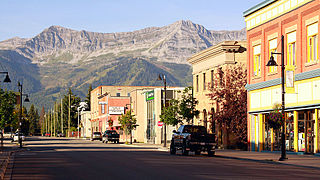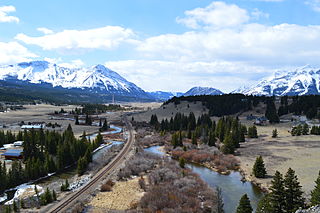
Fernie is a city in the Elk Valley area of the East Kootenay region of southeastern British Columbia, Canada, located on BC Highway 3 on the western approaches to the Crowsnest Pass through the Rocky Mountains. Founded in 1898 and incorporated as the City of Fernie in July 1904, the municipality has a population of over 5,000 with an additional 2,000 outside city limits in communities under the jurisdiction of the Regional District of East Kootenay. A substantial seasonal population swells the city during the winter months.

Crowsnest Pass is a low mountain pass across the Continental Divide of the Canadian Rockies on the Alberta–British Columbia border.

The Municipality of Crowsnest Pass is a specialized municipality in southwest Alberta, Canada. Within the Rocky Mountains adjacent to the eponymous Crowsnest Pass, the municipality formed as a result of the 1979 amalgamation of five municipalities – the Village of Bellevue, the Town of Blairmore, the Town of Coleman, the Village of Frank, and Improvement District No. 5, which included the Hamlet of Hillcrest and numerous other unincorporated communities.
Frank is an urban community in the Rocky Mountains within the Municipality of Crowsnest Pass in southwest Alberta, Canada. It was formerly incorporated as a village prior to 1979 when it amalgamated with four other municipalities to form Crowsnest Pass.

The Crowsnest River is a tributary to the Oldman River in southwestern Alberta, Canada.

The Frank Slide was a massive rockslide that buried part of the mining town of Frank in the District of Alberta of the North-West Territories, Canada, at 4:10 a.m. on April 29, 1903. Around 44 million cubic metres/110 million tonnes of limestone rock slid down Turtle Mountain. Witnesses reported that within 100 seconds the rock reached up the opposing hills, obliterating the eastern edge of Frank, the Canadian Pacific Railway (CPR) line and the coal mine. It was one of the largest landslides in Canadian history and remains the deadliest, as between 70 and 90 of the town's residents died, most of whom remain buried in the rubble. Multiple factors led to the slide: Turtle Mountain's formation left it in a constant state of instability. Coal mining operations may have weakened the mountain's internal structure, as did a wet winter and cold snap on the night of the disaster.
Henry L. Frank was an American politician and businessman based in Montana.

Coleman is a community in the Rocky Mountains within the Municipality of Crowsnest Pass in southwest Alberta, Canada. It was formerly incorporated as a town prior to 1979 when it amalgamated with four other municipalities to form Crowsnest Pass.

Bellevue is an urban community perched 4,280 feet elevation in the Rocky Mountains within the Municipality of Crowsnest Pass in southwest Alberta, Canada. It was formerly incorporated as a village prior to 1979 when it amalgamated with four other municipalities to form Crowsnest Pass.
Hillcrest, also known as Hillcrest Mines, is an urban community in the Rocky Mountains within the Municipality of Crowsnest Pass in southwest Alberta, Canada. It was once a hamlet under the jurisdiction of Improvement District (ID) No. 5 prior to 1979 when the former ID No. 5 amalgamated with four other municipalities to form Crowsnest Pass.

Blairmore is a community in the Rocky Mountains within the Municipality of Crowsnest Pass in southwest Alberta, Canada. It was formerly incorporated as a town prior to 1979 when it amalgamated with four other municipalities to form Crowsnest Pass. Blairmore is the principal commercial centre of Crowsnest Pass.

Nordegg is a hamlet in west-central Alberta, Canada within Clearwater County. It is in the North Saskatchewan River valley in the foothills of the Canadian Rockies, just east of the intersection of the David Thompson Highway and the Highway 734 spur of the Bighorn Highway. A former coal mining town, it was named after Martin Nordegg and the name probably means "North Corner" in a German dialect. The railway station name at the locality was called Brazeau rather than Nordegg at certain points in its history, but the local post office has always been named Nordegg. The name Brazeau is now obsolete.
Luscar is a ghost town in west-central Alberta, Canada that was once a coal mining community. It was in the foothills of the Northern Rockies about 12 kilometres (7.5 mi) northwest of Cadomin along the Bighorn Highway, at the end of the CN Railway line.
Coalspur is a nearly abandoned coal-mining and railroad town in Yellowhead County, Alberta. It is situated on Highway 47 beside the Embarras River in the foothills of the Canadian Rockies.

The Dunlap coke ovens are the remnants of a coke production facility near Dunlap, in the U.S. state of Tennessee. Built in the early 1900s, the facility consists of five batteries of 268 beehive ovens, which operated under various companies until the early 1920s. The ovens are now listed on the National Register of Historic Places, and are maintained by the Sequatchie Valley Historical Society as part of Dunlap Coke Ovens Park.
The Mist Mountain Formation is a geologic formation of latest Jurassic to earliest Cretaceous age in the Western Canada Sedimentary Basin that is present in the southern and central Canadian Rockies. It was named for outcrops along the western spur of Mist Mountain in Alberta by D.W. Gibson in 1979. The Mist Mountain Formation contains economically important coal seams that have been mined in southeastern British Columbia and southwestern Alberta.
The Greenhill Mine was a coal mine north of Blairmore, Alberta, Canada.
Coal in Alberta is found in the Coalspur Formation in the Western Canada Sedimentary Basin in the foothills of southwestern Alberta. The Coalspur Formation, which has large quantities of high-quality coal, runs from south of the Wapiti River to the North Saskatchewan River. The Coalspur coal zone is about 120 metres (390 ft) to 200 metres (660 ft) thick.
Passburg is a ghost town in the Municipality of Crowsnest Pass in southern Alberta, Canada that was formerly a coal mining community. It is on Highway 3 approximately 130 km (81 mi) west of Lethbridge and 4 km (2.5 mi) southeast of Bellevue.
The Grassy Mountain Coal Project was a proposed open-pit mine to produce metallurgical coal, initially submitted to the Alberta Energy Regulator by the Australian-based Benga Mining in 2015. The proposed mine was located on a previously abandoned mine site near Crowsnest Pass, Alberta, Canada in the eastern slopes of the Rocky Mountains. In their June 17, 2021 final report, the joint provincial-federal review panel composed of the Alberta Energy Regulator (AER) and the Minister of Environment and Climate Change Canada (ECCC) denied Benga Mining's application for the Grassy Mountain Coal Project because of significant adverse environmental effects.













